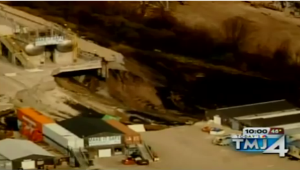 Halloween brought an unexpected scare to Oak Creek, Wisconsin: a coal ash slide along the shore of Lake Michigan. The We Energies’ site has stored coal ash since the 1960s. It’s too early to know what sort of geotechnical event precipitated the bluff’s collapse, but a nearby retaining pond is being drained as a precaution.
Halloween brought an unexpected scare to Oak Creek, Wisconsin: a coal ash slide along the shore of Lake Michigan. The We Energies’ site has stored coal ash since the 1960s. It’s too early to know what sort of geotechnical event precipitated the bluff’s collapse, but a nearby retaining pond is being drained as a precaution.
Waste from the hillside’s collapse has entered Lake Michigan. The exact mix of waste released has not been fully described, but a spokeswoman for We Energies has noted that coal ash was most likely part of it. The decades-old ash had been stored in an unlined system, like much of the coal ash in the United States.
For nearly 10 years, proper coal ash containment has been debated. The ash is a standard waste product produced in coal-fired electrical plants. The power industry has generally considered lined facilities, such as commonly utilized in the municipal solid waste industry, to be expensive. In the absence of clear regulation, coal ash has frequently been stored in unlined pits.
The massive December 2008 coal ash storage breach in Kingston, Tennessee, however, put the debate about ash storage firmly in the national spotlight. That spill released more than 5 million cubic yards of waste containing toxic substances such as arsenic, selenium, lead and mercury. The multi-year cleanup of the site has been estimated to cost more than $1.2 billion.
The Kingston facility had not been lined either.
Since that late 2008 spill, the US Environmental Protection Agency (EPA) has conducted a evaluations of ash impoundment facilities around the country and labeled more than 60 “high risk.” That is roughly 10% of the coal ash ponds in the nation.
Geosynthetic lining systems have been standard in the waste management industry for decades, and the high-degree of protection they have provided have helped make the sector the highest graded sector in the infrastructure "report cards" issued by the American Society of Civil Engineers (ASCE). A movement has been building in recent years to regulate coal ash storage under the same rules governing municipal waste–which would mean the use of geosynthetic containment technologies.
The Geosynthetic Materials Association (GMA) has played a strong role in extending this engineering knowledge at the federal legislative level, hosting annual meetings in Washington to discuss environmental protection with regulators, legislators and other influential figures.
In Oak Creek, Wisconsin, the cleanup activities will most likely be ongoing for a little while. Sediment containment booms have been deployed in the water to provide immediate enviromental containment while full site assessment and more detailed response planning takes place.
See a video report of the Oak Creek slide at the Milwaukee Journal Sentinel website and a series of photographs from the site.
Chris Kelsey is the editor of Geosynthetica, chris@geosynthetica.net.











